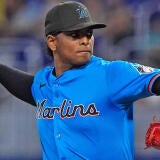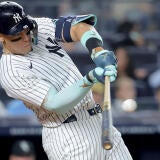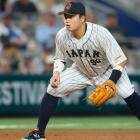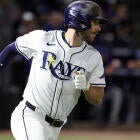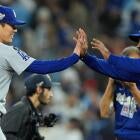Fantasy Baseball Today: Brent Rooker's power could make him a top-50 pick in 2025 drafts
Chris Towers highlights strengths and areas of concern in Brent Rooker's game
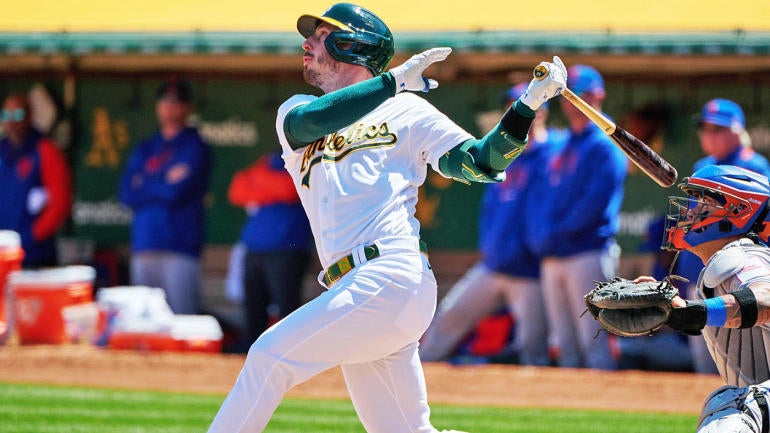
What's the comp for Brent Rooker? He was a decent option in his breakout 2023, hitting .246 with 30 homers, but he was a 28-year-old with very little prospect pedigree and a 33% strikeout rate, so nobody really took it seriously – he entered 2024 with an ADP in NFC Drafts of just 288.9, effectively undrafted in many leagues.
And here he sits, with less than two weeks left in the MLB season, ranked as the No. 9 player in Rotisserie leagues – overall! In H2H points leagues, unquestionably his worst format, he's only the No. 14 player to date, just ahead of first-rounders Corbin Carroll and Freddie Freeman. We knew Rooker had power, obviously, but the overall growth in his game we've seen this season? Well, let's just say the idea of Rooker hitting over .300 wasn't really taken seriously before this season.
Through 134 games, he's doing exactly that, hitting .302/.371/.585 with 38 homers, 10 steals, 79 runs, and 109 RBI. Rooker is basically having a Bryce Harper season, and the most surprising thing about it is … it might not even be a fluke! He's cut his strikeout rate to a more manageable 28.4% without sacrificing anything in terms of quality of contact. Quite the contrary, in fact, as Rooker has gone from a very good .472 expected wOBA on contact to a .534 mark this season, second only to Aaron Judge and Shohei Ohtani.
Rooker has been locked in from the very start, with an OPS of at least .857 in every month of the season save June (.725), and it's not like he's puttering across the finish line, either; his 1.043 OPS in the month of September to date is his second-best of any month this season. And the underlying numbers remain strong, as he has a .392 xwOBA over his past 100 PA and a .419 mark over his past 250 PA, compared to a season-long mark of .396. Nothing about this looks like a fluke!
And yet, I'm not sure anyone is really treating it like it's real, either. In a discussion on a recent episode of Fantasy Baseball Today, Frank Stampfl, Scott White, and myself all admitted we really don't know what to do with Rooker for 2025 rankings purposes yet. At one point, Scott said he'd "probably" have Rooker in the top-20 outfielder range -- though notably, Rooker is not likely to be outfield eligible next season -- which is a huge improvement over where he was ranked last season and would also represent a massive discount on Rooker's 2024 production. For comparison, last year, the No. 20 outfielder, Kyle Schwarber, was 80.9 in NFC ADP.
And if you think that's not giving Rooker enough credit, consider this: In one expert's draft for a league that will be played out for 2025, Rooker was the third pick of the 10th round – in a 15-team league, that means 138 players were picked ahead of him, including at least 27 outfielders. Again, Rooker is a top-10 player in Roto this season, providing plus production at least in all five categories, including, again, 10 steals!
I just spent several hundred words making it, but truthfully, the case for Rooker is quite self-explanatory. The burden of proof should be on those of us – yes, "us" – who are skeptical about what he's accomplished this season. So, what's the case against him, or at least the case for skepticism?
It starts with the lack of track record. Rooker has only played at this level for one year, and it isn't that dissimilar from Luke Voit's flash-in-the-pan run with the Yankees – remember, Voit, had a 905-PA stretch from 2018 through 2020, where he hit .278/.371/.541, more than 300 PA more than Rooker's 2024; combine 2023 and 2024 for Rooker, and you get a 1,092-PA sample size, but the line drops to .275/.351/.539. That would be pretty good for a 10th-round pick, so I'm actually not sure how much this argument against Rooker makes sense.
So, it comes down to a skill set that just feels kind of fragile. Rooker's improvements from 2023 haven't come along with a significant improvement in, say, plate discipline; if anything, he's just swinging a whole lot more, with his in-zone swing rate jumping from 66.1% to 73% and his out-of-zone rate jumping from 27.3% to 30.6%. He's making more contact on both types of swings, hence the lower strikeout rate, but you would think that all those extra batted balls on pitches out of the strike zone would come at a cost, and they just haven't so far. That's kind of curious.
But there's one more real red flag in Rooker's profile I want to highlight (though I don't necessarily think this is the reason everyone is skeptical of him). Of Rooker's 38 homers as of Tuesday, only three have come on pitches in the top third of the strike zone or higher. How weird is that? Of the four other players with at least 38 homers this season, here's how many have come on pitches in the top third of the zone (or higher):
- Aaron Judge: 4/53
- Shohei Ohtani: 13/47
- Anthony Santander: 12/41
- Juan Soto: 18/40
- Brent Rooker: 3/38
Rooker has a swing geared for power, but it's a very specific kind of power. As Ben Clemens noted for FanGraphs.com earlier this season, Rooker "swings hard … and swings with a pronounced uppercut." And while you might note that Judge's similar pace is a reason to be optimistic, I do think Judge is the kind of one-of-one outlier who makes any comparison tough – Rooker is no small dude, but Judge still has three inches of height on him, and it might just be tougher for pitchers to attack the top of the zone against him when they just aren't used to having to pitch that high that often. Just 17.8% of pitches to Judge are in that zone this season, compared to 26.2% to Rooker, and Judge's wOBA on those pitches is .396, compared to Rooker's .343; still solidly above average, but it could be a hole pitchers might be able to exploit.
But, I'll be honest: That kind of feels like reaching. There must be some reason Rooker can't keep getting away with this, and by god, we're going to find it! Rooker has poor plate discipline, but his swing decisions and whiff rate aren't much different than someone like Rafael Devers, who obviously hasn't been stopped by a free-swinging approach.
Maybe Rooker just has more holes in his swing that haven't been exploited this season, and there is one other way in which Rooker is an outlier right now: His swing speed and swing length. These are relatively new metrics, introduced to BaseballSavant.com just this season, but one thing became pretty clear once they were introduced: The faster your swing is, the longer your swing tends to be. But Rooker is a rare exception, as he is in the 80th percentile in swing speed but only in the 29th percentile in swing length; only four other hitters are at least at those levels. Rooker swings hard, but he is relatively direct to the ball, and maybe that combination can allow him to continue to demolish baseballs the way he has?
I'll be honest again: That one feels a bit like a reach. If you're looking for reasons to be optimistic about any player, there's no shortage of data you can find to make your case. I'm inclined to buy the skeptical case for Rooker, but I'm also starting to think I'm going to be higher than the consensus on him, too. Even baking in a ton of regression for 2025, you could rank him 75th, be higher than most, and still get a nice discount on his expected production.
I think that's where I'm going to land. Top-20 outfielder, for sure, and possibly top-15. I may come to regret that, but if Rooker just comes in between his 2023 and 2024, here's what a 162-game pace would look like .275 average, 84 runs, 41 homers, 106 RBI, eight steals. That's pretty good!
There's a chance the bottom falls out for the soon-to-be 30-year-old, and the Athletics' new home park in the minor-league Sacramento stadium is a big unknown and unknowable factor to consider for everyone in Oakland. But there just aren't a ton of holes to be poked in Rooker's 2024 profile, except for this one: His history didn't begin in 2024.




